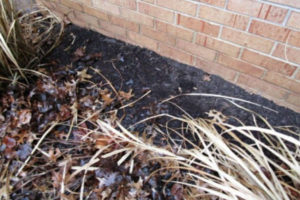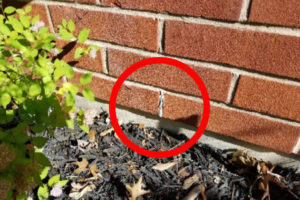What happens when you get sad or hurt? Tears build up, you start to cry, your weep holes release water. Likewise, when it rains, water builds up on exterior brick veneer walls and is released from the spaces between brick veneer and structural wood framing via weep holes.
Badness happens when your walls don’t have weep holes. Without weep holes, water has only one place to go – inside your home’s walls, leading to mold, rot, and unpleasant, expensive structural issues.
Bricks Don’t Have Eyes

Masonry is porous. Moisture can penetrate the surface and at siding junctions. You may have noticed that bricks don’t have eyes. Bricks can’t cry. Therefore, brick veneer walls require weep holes to permit moisture to escape from behind the veneer and to allow gaps between the brick veneer and the exterior sheathing to dry.
Where Are Weep Holes?
The law of gravity dictates that water escapes at the lowest point in the wall. Therefore, weep holes are at the bottom of brick veneer, just above the top of the foundation, and directly above the termination point of any flashing installed behind the brick. Weep holes also should be located above doors, above and below windows, and above any other openings in the brick wall.
How No Weep Holes?

Unfortunately, weep holes often are omitted or improperly located during construction; issues can go undetected until there is a home inspection. Weep hole issues also are common if the home was built before weep holes were required by code or if the local municipality didn’t require builders to follow code at the time of construction. And even if weep holes were required, builders or municipal inspectors may not have noticed any problems. And what’s even more disturbing is that some homeowners, thinking the holes are defective, caulk weep holes!
What Not to Do
DO NOT power up your drill. Drilling weep holes in the proper location is almost impossible because you don’t know the actual termination point of the flashing. If you drill weep holes in the wrong places, you could introduce water penetration, damage mortar, or open the wall to pests.
What to Do
There are two possible courses of action:
1) Do nothing. This makes sense for homes in which there is a track record of no visible signs of deterioration. Be watchful! Past performance isn’t always an indicator of future events. An Infrared Inspection can detect hidden problems.
2) Remove part of the brick veneer to verify proper installation of flashing. If you locate the flashing, you can reinstall the brick and ensure that weep holes are in their proper locations. Sadly, this would be a pretty significant expense.
Do your brick walls have weep holes?
Schedule an inspection if you want us to help you figure out if you have any weep hole issues.
